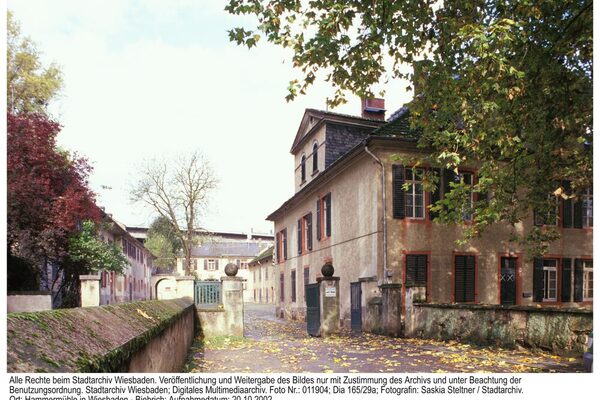Hammer mill
In 1690, the operator of the neighboring Armenruhmühle mill, Fritz Späth, built a grinding mill on land owned by the sovereign on the Salzbach stream with the permission of Georg August Samuel Prince of Nassau-Idstein. Until 1689, the iron hammer mill, which was destroyed by the French during raids, stood here and gave this mill site its name. After several changes of ownership, Bernhard May took over the hammer mill in 1807. When he took over, he found neglected and partly dilapidated buildings with outdated milling equipment. With considerable investment, he renovated and extended the buildings and renewed and improved the mill technology. The experience he gained during his apprenticeship in the production of white flour and the processing of his rye flour in his own bakery gave him a competitive advantage over his fellow millers. With the fortune he made from selling bread, the flour trade and the produce from his farm, he acquired the copper mill further up the Salzbach for his son, which he sold to the miller Adam Werner after his early death at a profit of 10,000 fl.
May also owned the Herrenmühle (castle mill) in Wiesbaden for a time. He thus joined the group of grand millers and former hammer millers Späth (Armenruh, hammer and salt mill) and Johann Adam Kretsch (copper, hammer, salt, electoral, new and fulling mill). Two years before his death (1856), he was one of the six richest tradesmen in the entire Duchy of Nassau. The Hammermüller's fame was enhanced by his large farm, which was operated with the most modern agricultural equipment. Everything belonging to the hammer mill was inherited by his daughter and her husband Christian Scholz. The mill and bakery continued to be run in May's spirit and the business prospered. However, the pollution of the Salzbach stream reduced the quality of life of the many mill residents. A legal action against the town led to the closure of the mill and bakery in 1887, after the heirs of Mr. and Mrs. Scholz had sold the mill and many plots of land to Gustav Dyckerhoff and Rudolf Dyckerhoff in 1882. After that, the building complex was used for agricultural purposes. Since 1924, the extensive former mill complex has housed apartments. The Hammermühle lives on in Wiesbaden's urban topography through the street names "An der Hammermühle" and "Bernhard-May-Straße".
Literature
The Hammermühle near Biebrich on the Rhine with special consideration of its former owner Bernhard May, Biebrich 1905.
